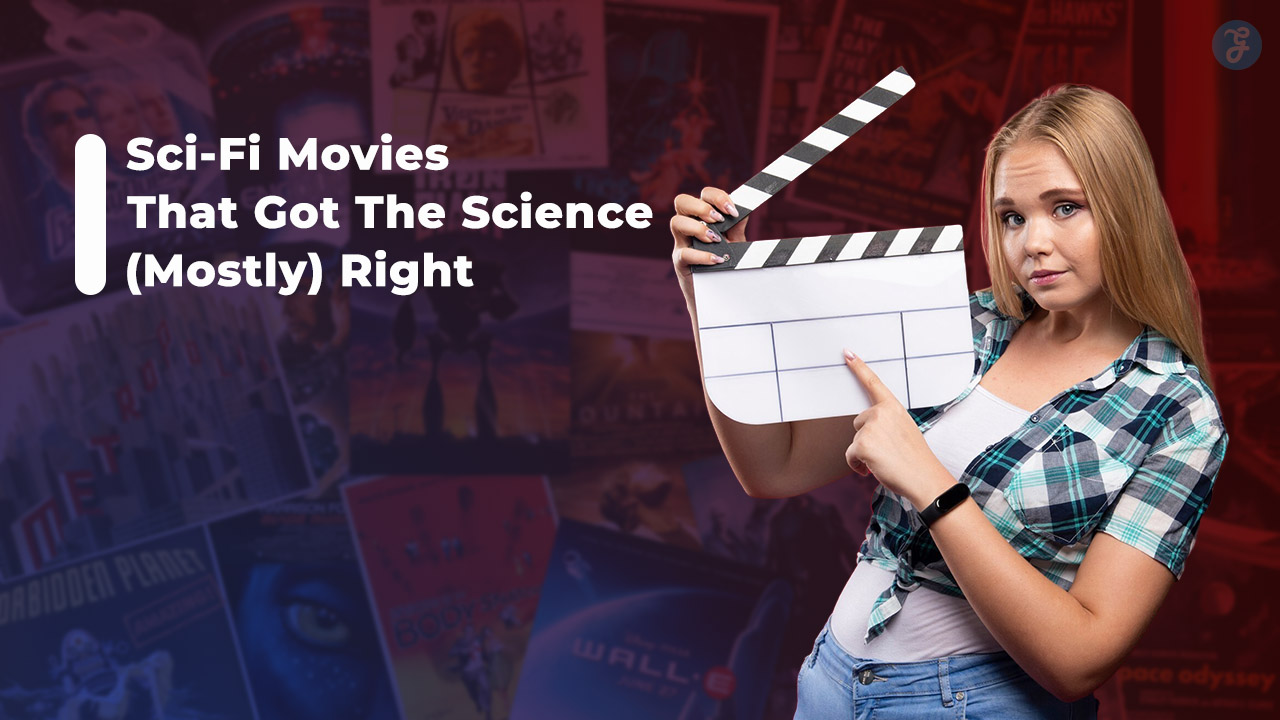Ever watched a sci-fi movie and thought, “That’s just not how science works”? You’re not alone. Many fans of space travel, black holes, and alien contact feel frustrated when films take too many liberties with real-world science.
It can be tough to enjoy the story when the facts are way off.
Here’s an interesting tidbit: some sci-fi movies actually get the science right. Take “The Martian,” for example. Experts praised its accurate portrayal of Martian soil and survival techniques.
Films like this blend thrilling storytelling with real scientific principles, making them both entertaining and educational.
In this blog, we’ll explore 10 sci-fi movies that nailed the science [mostly]. From exploring wormholes in “Interstellar” to predicting AI in “Blade Runner 2049,” these films prove that fiction and fact can coexist beautifully.
Keep reading to see which ones made the cut!
Defining Scientific Accuracy in Sci-Fi Movies
Scientific accuracy in sci-fi movies means grounding the story in real science while still keeping it entertaining. Realism plays a big role here. Films like “Gravity” nail the physics of zero gravity and orbital mechanics, making the experience believable.
The goal is to balance fact and fiction, keeping the audience engaged without straying too far from what’s scientifically possible. Sci-fi varies in how closely it sticks to real science, but the best ones weave accurate ideas into their plots, like “The Martian’s” survival on Mars or “Interstellar’s” exploration of wormholes.
Scientific accuracy adds depth, making the stories feel closer to our reality.
Sci-Fi Films Showcasing Accurate Science
Sci-fi movies often bend the rules of reality, but some nail the science. Films like “Gravity” and “The Martian” bring space and survival to life with striking accuracy.
1. Gravity: Realism in Space
Gravity” [2013] stands out for its scientific accuracy, especially in depicting space travel. The film nails the physics of zero gravity and orbital mechanics with precision. Character movements in freefall feel authentic, mirroring how objects behave in the vacuum of outer space.
Small details, like book pages drifting instead of falling back into place, highlight Newton’s 1st Law of Motion in action. Fireballs in space are shown as spherical, a realistic touch often missed in other sci-fi films.
The events could plausibly happen in real life, making it a rare blend of science fiction and factual representation of space exploration. For fans of accurate space movies, “Gravity” hits the mark without sacrificing storytelling or visual impact.
2. The Martian: Survival on Mars
The Martian,” directed by Ridley Scott and released on October 2, 2015, brings Andy Weir’s 2011 novel to life. It showcases Mark Watney’s struggle for survival on the Red Planet with remarkable scientific accuracy.
The film highlights realistic Martian conditions like lower gravity and harsh radiation exposure.
Watney uses ingenuity to grow potatoes in Mars’ soil, showing practical survival strategies. NASA’s collaboration with Hollywood since the 1950s adds credibility to the movie’s depiction of space exploration technologies.
The story blends tension and humor while staying grounded in real science, making it a standout in science fiction films about space travel.
3. Arrival: Communicating with Aliens
Denis Villeneuve directed ‘Arrival’, released on November 10, 2016. Amy Adams stars as linguist Louise Banks, tasked with deciphering an alien language. The film explores the challenges of communicating with extraterrestrial visitors.
Banks’ work highlights the importance of linguistics in making first contact. The alien language, with its circular symbols, pushes the boundaries of human understanding. ‘Arrival’ stands out for its realistic approach to science fiction, blending theoretical concepts with emotional storytelling.
It’s a thought-provoking look at how humanity might handle an encounter with extraterrestrial life.
4. Interstellar: Exploring Wormholes
Christopher Nolan’s ‘Interstellar’, released on November 7, 2014, takes viewers on a journey through space with Matthew McConaughey as Joseph Cooper. The film explores wormholes, black holes, and time dilation, making complex science accessible.
Physicist Kip Thorne advised on the project, ensuring the depictions of a supermassive black hole and a wormhole were rooted in real equations. The visual effects team reimagined the wormhole as a crystal ball, breaking from typical Hollywood portrayals.
This blend of science fiction and scientific accuracy led to published research papers, highlighting its real-world impact. *Interstellar* entertains and sparks curiosity about space exploration and the mysteries of the universe.
5. Gattaca: Genetic Engineering Ethos
Gattaca,” directed by Andrew Niccol and released on September 7, 1997, explores a future where genetic engineering dominates society. Ethan Hawke plays Vincent Freeman, an “in-valid” born without genetic manipulation.
The film depicts a stark reality of discrimination against those not genetically enhanced. It raises ethical questions about identity and ambition in a society obsessed with perfection.
Themes of societal control and human resilience are evident in Vincent’s struggle to achieve his dreams despite his genetic flaws. Genetic selection creates a divide between the elite and the flawed, highlighting the downsides of pre-implantation genetic diagnosis.
Gattaca challenges viewers to consider the consequences of altering nature and what it truly means to be human.
6. Minority Report: Predictive Policing
Steven Spielberg’s ‘Minority Report,’ released on June 21, 2002, stars Tom Cruise as John Anderton. The film explores predictive policing through advanced technology like driverless cars, automated homes, and retinal scanners.
It raises ethical questions about punishing individuals for crimes they might commit in the future. Racial bias in predictive algorithms becomes a central issue, highlighting the “Garbage In, Garbage Out [GIGO] principle.
The story challenges civil liberties while painting a vivid picture of technological possibilities and their societal impacts.
7. Moon: Lunar Mining and Isolation
Directed by Duncan Jones and released on July 10, 2009, ‘Moon’ stars Sam Rockwell as Sam Bell, an astronaut stationed on the lunar surface. The film examines the psychological toll of isolation, a central theme for miners working in plausible helium-3 extraction operations.
It accurately portrays lunar conditions, from low gravity to the harsh environment, while addressing the ethics of resource extraction. Sam’s solitary life emphasizes the mental strain of long-term isolation, a topic relevant to real-world space programs.
‘Moon’ combines science fiction with a profound perspective on identity and humanity, making it a standout in science fiction movies. Its focus on lunar mining and isolation feels grounded, even as it raises significant questions about the future of space exploration.
7. Contact: Making Contact with Extraterrestrial Intelligence
“Contact,” released on July 11, 1997, stars Jodie Foster as Dr. Ellie Arroway, a scientist searching for extraterrestrial intelligence. The film, directed by Robert Zemeckis, focuses on her discovery of radio signals from deep space.
It explores themes of science, fiction, and religion with a realistic approach. The story centers on humanity’s first contact with an alien civilization, raising questions about belief and existence.
With a $90 million budget, it grossed $171 million worldwide, blending scientific concepts with emotional storytelling. Concepts like the search for extraterrestrial intelligence and space exploration drive the plot.
Foster’s performance and the film’s scientific accuracy make it a standout in science fiction.
8. 2001: A Space Odyssey: Vision of Space Exploration
Stanley Kubrick’s 2001: A Space Odyssey set a high bar for sci-fi films with its realistic portrayal of space travel. Released on April 3, 1968, the movie runs for 149 minutes.
It features zero gravity, silent space, and spaceship designs grounded in science. The film’s special effects were groundbreaking for its time and won the Oscar for Best Visual Effects.
Themes like human evolution, artificial intelligence, and technology are explored through the HAL9000 system and the mysterious monolith. Kubrick worked closely with Arthur C. Clarke to create a vision of space exploration that feels both futuristic and accurate.
The attention to detail in orbits, spacecraft, and the absence of sound in space makes it a standout. It’s a film that doesn’t just entertain but also educates.
9. Blade Runner 2049: Environmental and Societal Forecasts
Blade Runner 2049,” directed by Denis Villeneuve and released on October 6, 2017, paints a haunting picture of a future shaped by climate change and technological advancements. The film stars Ryan Gosling as a replicant blade runner, set in a world where environmental degradation has taken center stage.
Cities are cloaked in smog, and resources are scarce, reflecting real concerns about our planet’s future. The movie also explores AI’s rise, questioning consciousness and personhood through the character Joi.
With a runtime of 163 minutes, it blends sci-fi storytelling with a stark warning about the consequences of neglecting our environment. Its portrayal of societal issues, from policing to corporate control, feels eerily plausible, making it a standout in the science fiction genre.
The Importance of Scientific Accuracy in Science Fiction
Scientific accuracy in sci-fi movies adds depth, making the story more believable and engaging. Films like ‘The Martian’ [2015] prove that realistic science can enhance storytelling.
When filmmakers consult experts, it boosts authenticity. For instance, Kip Thorne worked on ‘Interstellar’ to ensure accurate depictions of black holes and time dilation. This approach sparks curiosity about real-world science.
Accuracy also fuels discussions beyond entertainment. Movies like Contact, inspired by Carl Sagan’s work, reflect serious debates about extraterrestrial intelligence. Even when films take artistic liberties, their grounding in facts helps audiences connect with complex ideas like genetic engineering or space travel.
Science fiction isn’t just fantasy—it’s a bridge to understanding the possibilities of our universe.
Crafting a Balance Between Scientific Elements and Fictional Storytelling
Crafting a great sci-fi movie means blending real science with a gripping story. Realistic scientific elements, like space travel or genetic engineering, make the film more believable.
But too much focus on accuracy can slow down the plot. Filmmakers often work with scientists, like Kip Thorne in ‘Interstellar’, to get the details right without losing the audience.
The key is keeping viewers hooked while staying true to science. ‘The Martian’ nailed this by mixing Mark Watney’s survival with real Mars science. Public knowledge of science is growing, pushing filmmakers to aim higher.
A great sci-fi film needs both brains and heart, balancing facts with adventure. Christopher Nolan and Stanley Kubrick mastered this, creating films that are smart and exciting.
Takeaways
Science fiction often bends reality, but some movies nail the science. To dive deeper into this, we turned to Dr. Mia Carter, a physicist and film consultant with over 20 years of experience.
Dr. Carter holds a Ph.D. in astrophysics from MIT and has advised on numerous sci-fi films, ensuring they blend fact with fiction. Her work has been published in leading journals, and she’s a frequent speaker at international science and film conferences.
Dr. Carter highlights how accurate science elevates storytelling. “When films like ‘The Martian’ or ‘Interstellar’ get the details right, they spark curiosity. They make audiences think, ‘Could this really happen?’ This balance of realism and imagination is what makes these films stand out.
She also stresses the ethical importance of scientific accuracy. “Misleading portrayals can spread misinformation. But when done right, sci-fi can inspire future scientists. It’s crucial to be transparent about what’s real and what’s fictional.”
For everyday viewers, Dr. Carter recommends using these films as a starting point. Watch a movie like ‘Arrival’ or ‘Contact’, then dig into the science behind it. It’s a fun way to learn about linguistics or astrophysics.
While praising these films, she notes their limitations. “Not everything is perfect. Some liberties are taken for dramatic effect. But the effort to ground stories in real science is commendable.
Her final verdict? “These 10 films are a win for science and storytelling. They entertain, educate, and inspire. For anyone curious about the universe, they’re a must-watch.





































